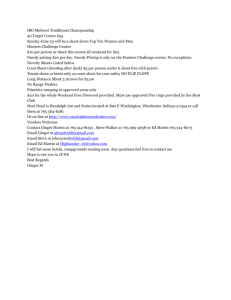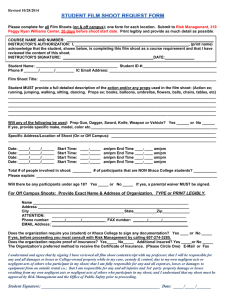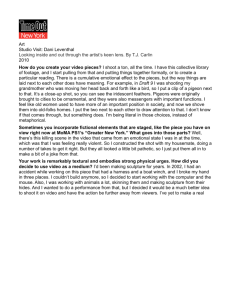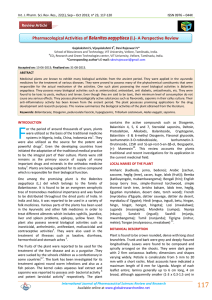Document 13309270
advertisement
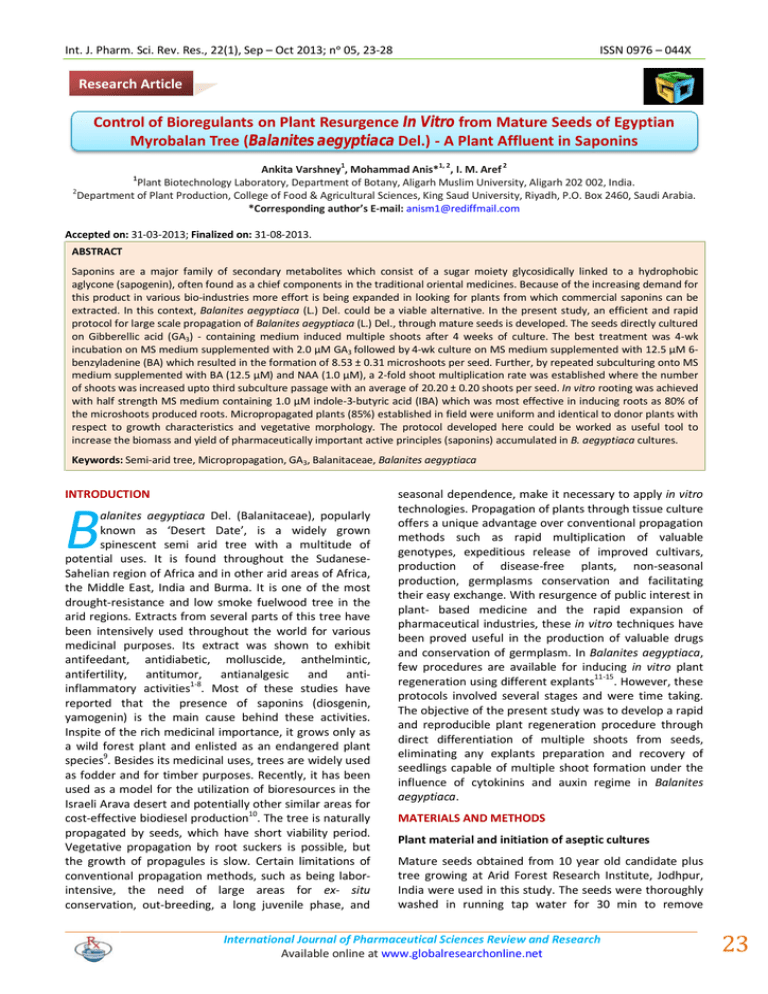
Int. J. Pharm. Sci. Rev. Res., 22(1), Sep – Oct 2013; nᵒ 05, 23-28 ISSN 0976 – 044X Research Article Control of Bioregulants on Plant Resurgence In Vitro from Mature Seeds of Egyptian Myrobalan Tree (Balanites aegyptiaca Del.) - A Plant Affluent in Saponins 1 1, 2 2 Ankita Varshney , Mohammad Anis* , I. M. Aref Plant Biotechnology Laboratory, Department of Botany, Aligarh Muslim University, Aligarh 202 002, India. 2 Department of Plant Production, College of Food & Agricultural Sciences, King Saud University, Riyadh, P.O. Box 2460, Saudi Arabia. *Corresponding author’s E-mail: anism1@rediffmail.com 1 Accepted on: 31-03-2013; Finalized on: 31-08-2013. ABSTRACT Saponins are a major family of secondary metabolites which consist of a sugar moiety glycosidically linked to a hydrophobic aglycone (sapogenin), often found as a chief components in the traditional oriental medicines. Because of the increasing demand for this product in various bio-industries more effort is being expanded in looking for plants from which commercial saponins can be extracted. In this context, Balanites aegyptiaca (L.) Del. could be a viable alternative. In the present study, an efficient and rapid protocol for large scale propagation of Balanites aegyptiaca (L.) Del., through mature seeds is developed. The seeds directly cultured on Gibberellic acid (GA3) - containing medium induced multiple shoots after 4 weeks of culture. The best treatment was 4-wk incubation on MS medium supplemented with 2.0 µM GA3 followed by 4-wk culture on MS medium supplemented with 12.5 µM 6benzyladenine (BA) which resulted in the formation of 8.53 ± 0.31 microshoots per seed. Further, by repeated subculturing onto MS medium supplemented with BA (12.5 µM) and NAA (1.0 µM), a 2-fold shoot multiplication rate was established where the number of shoots was increased upto third subculture passage with an average of 20.20 ± 0.20 shoots per seed. In vitro rooting was achieved with half strength MS medium containing 1.0 µM indole-3-butyric acid (IBA) which was most effective in inducing roots as 80% of the microshoots produced roots. Micropropagated plants (85%) established in field were uniform and identical to donor plants with respect to growth characteristics and vegetative morphology. The protocol developed here could be worked as useful tool to increase the biomass and yield of pharmaceutically important active principles (saponins) accumulated in B. aegyptiaca cultures. Keywords: Semi-arid tree, Micropropagation, GA3, Balanitaceae, Balanites aegyptiaca INTRODUCTION B alanites aegyptiaca Del. (Balanitaceae), popularly known as ‘Desert Date’, is a widely grown spinescent semi arid tree with a multitude of potential uses. It is found throughout the SudaneseSahelian region of Africa and in other arid areas of Africa, the Middle East, India and Burma. It is one of the most drought-resistance and low smoke fuelwood tree in the arid regions. Extracts from several parts of this tree have been intensively used throughout the world for various medicinal purposes. Its extract was shown to exhibit antifeedant, antidiabetic, molluscide, anthelmintic, antifertility, antitumor, antianalgesic and anti1-8 inflammatory activities . Most of these studies have reported that the presence of saponins (diosgenin, yamogenin) is the main cause behind these activities. Inspite of the rich medicinal importance, it grows only as a wild forest plant and enlisted as an endangered plant 9 species . Besides its medicinal uses, trees are widely used as fodder and for timber purposes. Recently, it has been used as a model for the utilization of bioresources in the Israeli Arava desert and potentially other similar areas for cost-effective biodiesel production10. The tree is naturally propagated by seeds, which have short viability period. Vegetative propagation by root suckers is possible, but the growth of propagules is slow. Certain limitations of conventional propagation methods, such as being laborintensive, the need of large areas for ex- situ conservation, out-breeding, a long juvenile phase, and seasonal dependence, make it necessary to apply in vitro technologies. Propagation of plants through tissue culture offers a unique advantage over conventional propagation methods such as rapid multiplication of valuable genotypes, expeditious release of improved cultivars, production of disease-free plants, non-seasonal production, germplasms conservation and facilitating their easy exchange. With resurgence of public interest in plant- based medicine and the rapid expansion of pharmaceutical industries, these in vitro techniques have been proved useful in the production of valuable drugs and conservation of germplasm. In Balanites aegyptiaca, few procedures are available for inducing in vitro plant 11-15 regeneration using different explants . However, these protocols involved several stages and were time taking. The objective of the present study was to develop a rapid and reproducible plant regeneration procedure through direct differentiation of multiple shoots from seeds, eliminating any explants preparation and recovery of seedlings capable of multiple shoot formation under the influence of cytokinins and auxin regime in Balanites aegyptiaca. MATERIALS AND METHODS Plant material and initiation of aseptic cultures Mature seeds obtained from 10 year old candidate plus tree growing at Arid Forest Research Institute, Jodhpur, India were used in this study. The seeds were thoroughly washed in running tap water for 30 min to remove International Journal of Pharmaceutical Sciences Review and Research Available online at www.globalresearchonline.net 23 Int. J. Pharm. Sci. Rev. Res., 22(1), Sep – Oct 2013; nᵒ 05, 23-28 adherent particles, immersed in 1% (w/v) solution of Bavistin, a fungicide for 30 min, then treated with 5% (v/v) Teepol solution for 20 min and rinsed thrice with sterile distilled water followed by surface sterilization in 0.1% (w/v) mercuric chloride solution under sterile conditions for 10 min and rinsed thrice with sterile distilled water. The disinfected seeds were inoculated aseptically on sterile culture medium. Culture of seeds on media containing GA3 and subsequent shoot multiplication and elongation on media containing cytokinins and auxin MS16 medium containing GA3 at different concentrations (0.5, 1.0, 2.0, 2.5 and 5 µM) singly was tested for seed germination. MS medium devoid of plant growth regulators was used as control. After 4 weeks, multiple shoots developed on seeds incubated in GA3 containing medium were transferred to MS medium supplemented with cytokinins BA and TDZ singly at different concentrations (0.5-15.0 M) as well as in combination with auxin NAA (0.5-5.0 M) for further multiplication and elongation. Subculturing was performed at 4 weeks intervals. Data on the shoot induction and multiplication per seed was recorded after 4 and 8 weeks respectively. Culture conditions All the media were supplemented with 3 % (w/v) sucrose and gelled with 0.8 % (w/v) bacteriological grade agar (Qualigens, India). The medium was adjusted to pH 5.8 using 1 N NaOH or HCl and sterilized by autoclaving at 121°C for 15 min. One seed was inoculated per culture bottle with 10 seeds per treatment; shoots developed on seeds were cultured in a 25 X 150 mm culture tube (Borosil, India) containing 20 ml of sterilized semisolid media for multiplication and 100- ml conical flasks (Borosil, India) containing 50 ml of semisolid media were used for shoot elongation. The cultures were maintained in a culture room, illuminated by two cool white fluorescent lamps (40 W, Philips, India) at photon fluence -2 -1 density of 50 µmol s for 16 h per day with the maintained temperature of 25 ± 2°C. In vitro rooting and acclimatization Microshoots with fully expanded leaves were excised and transferred for rooting on half strength MS medium supplemented with IBA, NAA and IAA (0.1- 5.0 M) singly. All the culture conditions were similar as described for the shoot cultures. Data on percent rooting, number of roots per shoot and root length were recorded after 4 weeks. Shoots with well developed roots were removed from the culture vessel and rinsed with running water to remove agar. Plantlets were transferred to 10-cm-diameter thermocol cups containing SoilriteTM (Keltech Energies Ltd., India). Potted plantlets were covered with transparent plastic bags to ensure high humidity and watered at regular intervals with half strength MS salt solution lacking vitamins. Plastic bags were opened and ISSN 0976 – 044X gradually removed over a period of 10 days. The plants were then transferred to soil under natural conditions. Statistical analysis Ten replicates were used in each treatment and all experiments were repeated thrice. The data of different treatments was quantified and subjected to statistical analysis using One Way Analysis of Variance (ANOVA) and pair wise means compared using Duncan’s Multiple Range Test procedure (p < 0.05). The results were represented as mean ± standard error (SE). All the statistical analyses were performed using the SPSS statistical package software, version 10 (SPSS Inc., Chicago, USA). RESULTS Effect of GA3 on seed germination and formation of multiple shoots Seed germination took place within 2 weeks of inoculation. The seedling from the control (MS basal medium) developed one main shoot per seed with two or three nodes whereas those from GA3 containing medium developed 2-4 shoots per seed, each containing one to two nodes after 4 weeks of culture. Elongation of the main shoot was inhibited, and axillary shoots were formed flanking the cotyledonary node. However, no shoots were differentiated from the cotyledons or hypocotyl. The main root was long and thick without lateral roots. The green cotyledons remained unchanged in color and size compared to those on control. The bud clusters were formed on shoots which were not in contact with the medium (except for the roots). On medium containing 1.0 µM GA3, 2.93 ± 0.58 shoots were produced per seedling after 4 weeks. Moreover, the number (4.23 ± 0.17) of shoots per seedling was greatest at the 2.0 µM GA3 and attained shoot length of 2.00 ± 0.28 cm in 4 weeks (Table 1, Fig. 1a). Though, new shoot initials continued to form even after 4 weeks on GA3 containing medium, the older shoots started browning and withered away. Table 1: Effect of GA3 at different concentrations in MS medium on germination and multiple shoot formation in seeds after 4 weeks of culture GA3 (µM) % Response Mean no. of shoots/seed d 0.0 82 1.00 ± 0.00 0.5 29 1.73 ± 0.27 1.0 60 2.93 ± 0.58 2.0 88 4.23 ± 0.17 2.5 51 2.70 ± 0.15 5.0 41 1.20 ± 0.28 Mean shoot length (cm) d 0.53 ± 0.17 c 1.00 ± 0.11 bcd b 1.50 ± 0.28 a 2.00 ± 0.28 bc 1.23 ± 0.14 c 0.80 ± 0.05 ab a bc cd Values represent means ± SE. Values followed by the different letters within columns are significantly different (P = 0.05) using Duncan’s multiple range test International Journal of Pharmaceutical Sciences Review and Research Available online at www.globalresearchonline.net 24 Int. J. Pharm. Sci. Rev. Res., 22(1), Sep – Oct 2013; nᵒ 05, 23-28 ISSN 0976 – 044X passages. At third subculture, the shoot number reached to 5.80 ± 0.30 with an average length of 4.00 ± 0.05 cm. However, maximum number (7.33 ± 0.38) of shoots was recorded at fourth subculture passage and thereafter the number got stabilized at fifth passage (Fig. 2). The regenerated shoots obtained were healthy with well developed leaves. Figure 1: (A-D) Multiple shoot and plantlet regeneration from intact seedling of Balanites aegyptiaca A. Multiple shoots with expanded leaves developing from intact seedling on GA3 (2.0 µM) containing medium after 4 weeks of culture initiation. B. Prolific elongation of multiple shoots excised from intact seedling on MS medium containing BA (12.5 µM) and NAA (1.0 µM) after 8 weeks of culture. C. Rooted plantlet D. The acclimatized plants hardened in soil Synergistic effect of cytokinin (BA) and auxin (NAA) To overcome the initial low morphogenic response, the multiple shoots developed from seeds were excised and transferred to MS medium augmented with BA (12.5 µM) in synergy with NAA at different concentrations (0.5, 1.0, 2.0 and 5.0 µM). On medium containing BA (12.5 µM) and NAA (0.5 µM), 80% cultures showed the formation of 9.20 ± 0.62 shoots per culture after 8 weeks (Table 2). These BA-NAA conjunctions accentuated the morphogenic response and facilitated the growth of axillary shoots significantly. Among all concentrations of the BA-NAA combination used, the maximum number (12.7 ± 0.14) of shoots and shoot length (6.53 ± 0.37 cm) per culture were obtained at 12.5 µM BA with 1.0 µM NAA after 8 weeks of culture (Table 2; Fig. 1b). Effect of TDZ and subculturing The effect of TDZ at different concentrations was also tested to enhance the multiplication rate of the multiple shoots obtained from seeds. Among different concentrations used, TDZ (5.0 M) produced maximum number of shoots per seed (4.50 ± 0.28) with shoot length of 2.86 ± 0.12 cm after 4 weeks whereas at the higher concentrations (10.0-15.0 µM) the number of shoots declined (Table 3). However, the shoot multiplication rate was increased when the shoot clusters were transferred to TDZ free MS medium and subcultured for five Figure 2: Growth and development of shoots obtained from intact seedlings subcultured for different number of passages on MS medium without TDZ. Bars represent means ± SE. Bars denoted by the same letter within response variables are not significantly different (P=0.05) using Duncan’s multiple range test. Table 2: Effect of NAA at different concentrations with an optimal concentration of BA (12.5 µM) on shoot multiplication of intact seedlings after 8 weeks of culture NAA (µM) % Response 0.5 1.0 2.0 2.5 80 85 75 60 Mean no. of shoots/seed b 9.20 ± 0.62 a 12.76 ± 0.14 c 6.56 ± 0.65 d 4.60 ± 0.34 Mean shoot length (cm) ab 5.26 ± 0.74 a 6.53 ± 0.37 b 3.90 ± 0.17 b 4.16 ± 0.76 Values represent means ± SE. Values followed by the different letters within columns are significantly different (P = 0.05) using Duncan’s multiple range test. Table 3: Effect of TDZ on multiple shoots excised from intact seedlings after 4 weeks of culture TDZ (µM) % Response Mean no. of shoots/seed c 1.0 2.5 5.0 20 29 67 2.30 ± 0.11 b 2.90 ± 0.20 a 4.50 ± 0.28 10.0 12.5 15.0 30 18 15 2.26 ± 0.14 c 2.16 ± 0.16 c 2.00 ± 0.00 c Mean shoot length (cm) d 1.76 ± 0.14 bc 2.23 ± 0.24 a 2.86 ± 0.12 ab 2.56 ± 0.17 d 1.23 ± 0.14 d 1.16 ± 0.27 Values represent means ± SE. Means followed by the same letter within columns are not significantly different (P =0.05) using Duncan’s multiple range test. International Journal of Pharmaceutical Sciences Review and Research Available online at www.globalresearchonline.net 25 Int. J. Pharm. Sci. Rev. Res., 22(1), Sep – Oct 2013; nᵒ 05, 23-28 Rooting To promote the development of the root system, 4-5 cm long shoots were transferred on half strength MS medium augmented with IBA, NAA and IAA alone at different concentrations (Table 4). Half-strength hormone-free MS medium failed to induce roots from excised shoots after 4 weeks of culture. The addition of auxin in half strength MS medium was essential for root induction. The development of roots took place within 2 weeks of incubation without an intervening callus phase on all the auxin containing rooting media. The augmentation of IBA to half strength MS medium enhanced rooting ISSN 0976 – 044X significantly with the formation of healthy and longer roots. On the medium containing NAA and IAA singly, roots were thick and stunted. The best rhizogenic response was recorded at 1.0 M IBA where an average of 8.10 0.60 roots with 4.3 ± 0.37 cm root length was recorded after 4 weeks of culture (Table 4, Fig.1c). Plantlets were successfully hardened-off (Fig. 1d) according to the procedure explained in ‘Materials and methods’ and about 85% of the plantlets transferred to garden soil survived after 8 weeks and they did not show any detectable variation in morphology or growth characteristics when compared to the donor plants. Table 4: Influence of different auxins in ½ MS medium on in vitro rooting of the microshoots after 4 weeks of culture Auxins (µM) % Rooting Mean no. of roots /shoot - 53 3.33 ± 0.29 - 62 3.83 ± 0.17 IBA NAA IAA 0.1 - 0.5 - Mean root length (cm) cde 1.30 ± 0.32 cd 2.36 ± 0.29 a 4.30 ± 0.37 b 3.16 ± 0.17 defg 2.83 ± 0.17 defg 1.10 ± 0.25 def 2.06 ± 0.23 c 3.56 ± 0.23 1.0 - - 80 8.10 ± 0.60 2.0 - - 70 5.63 ± 0.37 5.0 - - 61 2.60 ± 0.49 - 0.1 - 45 2.60 ± 0.49 - 0.5 - 60 2.80 ± 0.28 - 1.0 - 73 4.30 ± 0.62 - 2.0 - 64 2.26 ± 0.49 hij cdef a bc bcde ij defgh b efgh 2.46 ± 0.26 fghi cde 1.83 ± 0.37 ghi 0.90 ± 0.20 fghi 1.56 ± 0.17 bc 3.00 ± 0.05 efghi - 5.0 - 54 1.86 ± 0.08 - - 0.1 44 1.46 ± 0.27 - - 0.5 56 1.76 ± 0.35 - - 1.0 68 4.33 ± 0.33 - - 2.0 62 1.26 ± 0.23 hi 2.13 ± 0.08 - - 5.0 49 0.95 ± 0.05 i 1.50 ± 0.28 j ghij bc defg ghi Values represent means ± SE. Values followed by the different letter within columns are significantly different (P=0.05) using Duncan’s multiple range test. DISCUSSION The viability of any species depends on the balance between extinction and colonization. Because of the rarity of colonization, the survival of species as a whole critically depends upon the survival of the population and germination of the seeds. The use of seeds is generally a preferable approach to conserve a species, because it helps in conserving the genetic variation in the species. If plants are multiplied from seeds, the genetic diversity of local ecotypes is maximized17. Each species has particular requirements for seed germination18. The germination obtained on MS basal medium was found unsatisfactory for Balanites aegyptiaca, since only 20 % seeds were germinated after 4 weeks. Observing the seed germination rate, we assume that seeds were under the influence of high dormancy due to physiological and biochemical factors. In the past, the usefulness of germinating seeds in the presence of cytokinins or a substance with cytokinin like acitivity for subsequent regeneration from seedling explants has been shown in Phaseolus vulgaris 19, Cajanus cajan20, Murraya koenigii21, Dendrocalamus asper 22, Litchi chinensis 23, Sterculia 24 25 urens and Pisum sativum . However, in the present study, the seeds cultured on GA3 supplemented medium elicited the morphogenic response ranging from 29 to 80 % seed germination into healthy intact seedlings. Hence, the data from the current study provide strong evidence that GA3 added to the medium affects the percentage response and the number of shoots regenerated per seed. The reason for this morphogenesis may be the stimulatory effects of GA3 on cell enlargement and cell division, because it is a very potent hormone. The induction of multiple shoots on seeds occurred frequently when seedlings were exposed to low levels of GA3, implying that in Balanites aegyptiaca organogenesis can also be induced from tissues without meristems. In the best treatment of germination (culture of seeds on GA3 2.0 µM for 4 weeks), more than 4 shoots were isolated from one seed. This shoot clump can produce about 20 shoots per explant when transferred to a medium containing BA (12.5 µM) and NAA (1.0 µM). Such high International Journal of Pharmaceutical Sciences Review and Research Available online at www.globalresearchonline.net 26 Int. J. Pharm. Sci. Rev. Res., 22(1), Sep – Oct 2013; nᵒ 05, 23-28 multiplication rates have not been reported before in Balanites aegyptiaca. The benefits of using GA3 singly or in combination with other plant growth regulators in the culture medium for shoot multiplication has been well 26,27,28 documented in number of plant species . The high number of axillary buds produced in the presence of cytokinin, especially BA, is consistent with the general knowledge that cytokinins overcome apical dominance, release lateral buds from dormancy and promote shoot formation. BA has successfully been used to induce axillary shoot proliferation in Murraya koenigii 21, Litchi chinensis23 and Sterculia urens24. An approximately 2-fold increase in the shoot number following the inclusion of a low concentration of NAA (0.5- 5.0 µM) into BAsupplemented medium suggests an interactive effect between the cytokinin and auxin on shoot proliferation. Anis et al. (2010)15 also reported significantly fair number of shoots in Balanites aegypticaca on interaction of BA (12.5 µM) and NAA (1.0 µM). The optimal endogenous and exogenous cytokinin/ auxin balance subsequently controlled the development and elongation of shoots. Our results were consistent with the findings of Siddique and Anis (2009)14and Anis et al.(2010)15 where the combination of BA and NAA was most effective for shoot regeneration. On increasing the concentration of BA to 15.0 µM or NAA to 5.0 µM, the shoot multiplication was adversely affected and significantly low rates of multiplication were obtained. The shoots regenerated on MS medium supplemented with optimal concentration of TDZ (5.0 µM) were transferred to hormone free MS basal medium for further shoot proliferation because continued presence of TDZ was found to be destructive for growth and shoot duplication14,15,29. Similar response of subculturing on shoot multiplication was also reported by Siddique and Anis (2009)14 where healthy shoots were observed at fifth subculture passage in Balanites aegyptiaca. Micropropagation protocols are successful only when the rate of survival of the in vitro regenerated plantlet is very high after transplantation. This in turn depends mainly on the development of a proper root system. The rooting experiments conducted in our study revealed that the presence of an exogenous auxin was essential for in vitro root induction of microshoots and IBA has been found to be the most effective auxin for in vitro rooting in Balanites shoots, followed by NAA and IAA. IBA has been reported to have stimulatory effect on root induction in earlier reports of Balanites aegyptiaca14,15 as well as in other tree species30,31,32. The superior effects of IBA on the root development may be due to several factors such as its preferential uptake, transport and stability over 33 other auxins and subsequent gene activation . The poor rooting response on a media supplemented with IAA may be due to the fact that exogenous application of IAA is rapidly inactivated in excised plant tissue by IAA 34 oxidase . The rooted plantlets appear to be phenotypically normal and grew well when transferred to field. ISSN 0976 – 044X CONCLUSION The entire process of regeneration starting from a seed up to the stage of establishment of regenerants in soil took approximately 6 months, and large number of plants could be recovered from each cultured seed. Thus, the method of using seeds in culture for obtaining high frequency direct shoot proliferation as reported herein will simplify micropropagation aimed at large scale multiplication. The regeneration protocol bypasses the step of explant preparation. Owing to the differentiation in intact seedlings, the number of manipulations required to induce regeneration is reduced to one in comparison to several procedures involving the culture of various explants. The regeneration protocol described could benefit the conservation of B. aegyptiaca and also provide sufficient juvenile plant material to attempt to exploit this important medicinal species by biotechnological means for the extraction of diosgenin and for prophylactic and therapeutic purposes. Acknowledgements: Authors gratefully acknowledge the Department of Science and Technology, and the University Grant Commission, Govt. of India, New Delhi for providing research support under DST-FIST (2005) and UGC-SAP DRS-I (2009) Programs, respectively. REFERENCES 1. Lui HW, Nakanishi K, The structures of Balanitisins, Potent molluscides isolated from Balanites aegpytiaca, Tetrahedron, 38, 1982, 513-519. 2. Jain DC, Tripathi AK, Insect feeding – detergent activity of saponin glycosides, Phyto. Res., 5, 1991, 139-141. 3. Ibrahim AM, Anthelmintic activity of some Sudanese medicinal plants, Phyto. Res. 3, 1992, 155-157. 4. Rao MV, Shah KD, Rajini M, Contraceptive efficacy of Balanites roxburghii pericarp extract in male mices (Mus musculus), Phyto Res., 11, 1997, 469-471. 5. Corbiere C, Liagre B, Bianchi A, Bordji K, Duaca M, Netter P, Beneytout JL, Different contribution of apoptosis to the antiproliferative effects of diosgenin and other plant steroids, hecogenin and tigogenin, on human 1547 osteosarcoma cells, Int. J. Oncol., 22, 2003, 899-905. 6. Chapgain B, Wiesman Z, Variation in diosgenin level in seed kernels among different provenances of Balanites aegyptiaca Del (Zygophyllaceae) and its correlation with oil content, Afri. J. Biotechnol., 4, 2005, 1209-1213. 7. Gnoula C, Megalizzi V, Neve De N, Sauwage S, Ribaucour F, Guissou P, Duez P, Dubois J, Ingrassia L, Lefranc F, Kiss R, Mijatovic T, Balanitin-6 and -7: Diosgenyl saponins isolated from Balanites aegyptiaca del. display significant antitumor activity in vitro and in vivo, Int. J. Oncol., 32, 2008, 515. 8. Gaur K, Nema RK, Kori ML, Sharma CS, Singh V, Antiinflammatory and analgesic activity of Balanites aegyptiaca in experimental animals models, Int. J. Green Pharma., 2009, 214- 217. 9. Nour M El, Khalifa MK El, Hassen B El, Preliminary study on seed pregermination treatment and vegetative International Journal of Pharmaceutical Sciences Review and Research Available online at www.globalresearchonline.net 27 Int. J. Pharm. Sci. Rev. Res., 22(1), Sep – Oct 2013; nᵒ 05, 23-28 ISSN 0976 – 044X propagation of Balanites aegyptiaca (L.) Del., In: Physiology des Arbes et Arbustes en zone arides et semi- arides. Groupe d’Etude de l’arbre – Paris, France, 1991, 413-415. 23. Das DK, Shiv Prakash N and Bhalla-Sarin N, Multiple shoot induction and plant regeneration in litchi (Litchi chinensis Sonn.), Plant Cell Rep., 18, 1999, 691-695. 10. Chapagain B, Yehoshua Y, Wiesman Z, Desert date (Balanites aegyptiaca) as an arid lands sustainable bioresource for biodiesel, Bio. Technol. ,100, 2009,12211226. 24. Hussain TM, Chandrasekhar T, Gopal GR, Micropropagation of Sterculia urens Roxb., an endangered tree species from intact seedlings, Afri. J. Biotechnol., 7, 2008, 095-101. 11. Ndoye M, Diallo I, Gassama/Dia YK, In vitro multiplication of the semi- arid forest tree, Balanites aegyptiaca L. Del., Afri. J. Biotechnol., 2, 2003, 421-424. 25. Zhihui S, Tzitzikas M, Raemakers K, Zhengqiang M, Visser R, Effect of TDZ on plant regeneration from mature seeds in pea (Pisum sativum), In Vitro Cell. Dev. Biol.- Plant., 45, 2009, 776-782. 12. Gour VS, Emmanuel CJSK, Kant T, Direct in vitro shoot morphogenesis in desert date- Balanites aegyptiaca (L) Del from root segments", Multipurpose Trees in the Tropics: Management and Improvement Strategies, 2005, 701-704. 26. Kotsias D, Roussos PA, An investigation on the effect of different plant growth regulating compounds in in vitro shoot tip and node culture of lemon seedlings, Sci. Hortic., 89, 2001, 115–128. 13. Gour VS, Sharma SK, Emmanuel CJSK, Kant T, A rapid in vitro morphogenesis and acclimatization protocol for Balanites aegyptiaca (L.) Del- a medicinally important xerophytic tree, J. Plant Biochem. Biotechnol., 16, 2007,151-153. 27. Farhatullah Abbas Z, Abbas SJ, In vitro effects of Gibberellic acid on morphogenesis of potato explants, Int. J. Agri. Biol., 9, 2007, 181-182. 14. Siddique I and Anis M, Direct plant regeneration from nodal explants of Balanites aegyptiaca L. (Del.): a valuable medicinal tree, New Fores., 37, 2009, 53-62. 15. Anis M, Varshney A, Siddique I, In vitro clonal propagation of Balanites aegyptiaca (L.) Del., Agrofores. Syst., 78, 2010, 151-158. 16. Murashige T, Skoog F, A revised medium for rapid growth and bioassays with tobacco tissue cultures, Physiol. Planta., 15, 1962, 473– 497. 17. Fay MF, Conservation of rare and endangered plants using in vitro methods, In Vitro Cell. Dev. Biol., 28, 1992, 1-4. 18. Schutz W, Milberg P, Seed dormancy in Carex canescens: regional differences and ecological consequences, Oikos., 78, 1997, 420-428. 19. Malik KA, Saxena PK, Somatic embryogenesis and shoot regeneration from intact seedlings of Phaseolus actuifolius A., P.aureus (L.) Wilczek, P. concineus L., P. wrightii, Plant Cell Rep., 11, 1992, 163-168. 28. Moshkov IE, Novikova GV, Hall MA, George EF, Plant growth regulators III: gibberellins, ethylene, abscisic acid, their analogues and inhibitors; miscellaneous compounds. In: George EF, Hall MA, De Klerk GJ (eds) Plant propagation by tissue culture, Springer, The Netherlands, 2008, 227– 282. 29. Varshney A, Anis M, Improvement of shoot morphogenesis in vitro and assessment of changes of the activity of antioxidant enzymes during acclimation of micropropagated plants of Desert Teak, Acta Physiologiae Plantarum, 34, 2012, 859-867. 30. Sha Valli Khan PS, Prakash E, Rao KR, In vitro propagation of an endemic fruit tree Syzygium alternifolium (wight) Walp., Plant Cell Rep., 16, 1997, 325-328. 31. Hossain SN, Munshi MK, Islam MR, Hakim L, Hossain M, In vitro propagation of Plum (Zyziphus jujuba Lam.), Plant Cell Tiss. Org. Cult., 13, 2003, 81-84. 32. Metivier PSR, Yeung EC, Patel KR, Thorpe TA, In vitro rooting of microshoots of Cotinus coggygria Mill, a woody ornamental plant, In Vitro Cell. Dev. Biol.- Plant, 43, 2007, 119-123. 20. Prakash S N, Deepak P, Neera BS, Regeneration of pigeon pea (Cajanus cajan L.) from cotyledonary node via multiple shoot formation, Plant Cell Rep., 13, 1994, 624-627. 33. Ludwig-Muller J, Indole-3-butyric acid in plant growth and development, Plant Growth Regul., 32, 2000, 219–230. 21. Bhuyan KK, Pattnaik S, Chand PK, Micropropagation of Curry leaf tree [Murraya koenigii (L.) Spreng.] by axillary proliferation using intact seedlings, Plant Cell Rep., 16, 1997,779-782. 34. Sembdner DG, Liebisch HW, Schneider G, Biosynthesis and metabolism of plant hormones. In: encyclopedia of plant physiology- hormonal regulation of development, I. Molecular Aspects of Plant Hormones, Vol.9. ed. Macmillan J., Springer- Verlag, Berlin, 1980, 281-444. 22. Arya S, Sharma S, Kaur R, Dev A, Micropropagation of Dendrocalamus asper by shoot proliferation using seed, Plant Cell Rep., 18,1999, 879-882. Source of Support: Nil, Conflict of Interest: None. International Journal of Pharmaceutical Sciences Review and Research Available online at www.globalresearchonline.net 28

